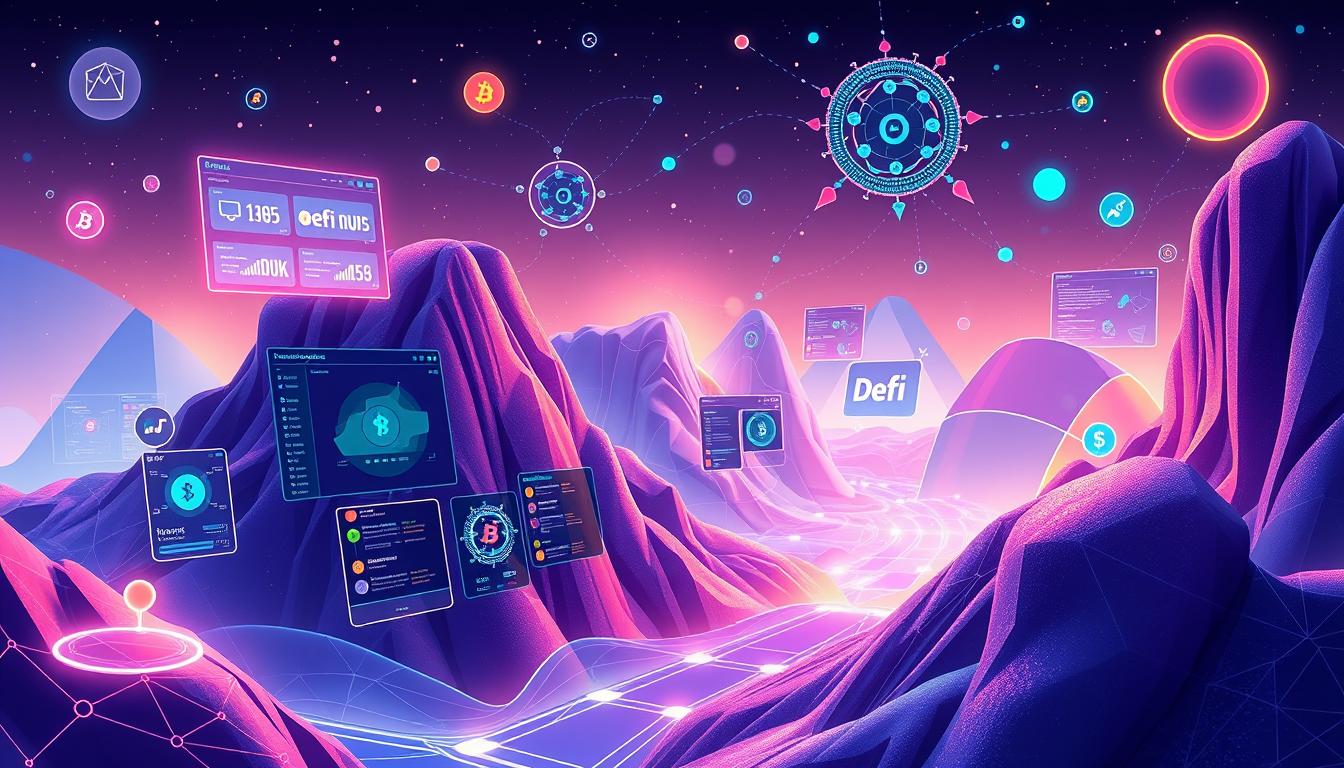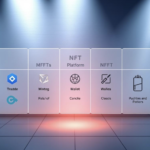Now Reading: DeFi Platforms for Beginners: Your Essential Guide
- 01
DeFi Platforms for Beginners: Your Essential Guide
DeFi Platforms for Beginners: Your Essential Guide

Welcome to the exciting world of Decentralized Finance (DeFi) platforms! As the blockchain technology revolutionizes the financial landscape, DeFi has emerged as a transformative force, offering a new paradigm of accessible and transparent financial services. In this comprehensive guide, we’ll explore the fundamentals of DeFi, uncover its key benefits, and provide you with a roadmap to navigate the diverse ecosystem of DeFi platforms as a beginner.
Decentralized Finance (DeFi) platforms leverage blockchain technology to create a new financial system that is open, transparent, and accessible to anyone with an internet connection. By eliminating the need for traditional financial intermediaries, DeFi platforms empower individuals to take control of their financial lives, engaging in a wide range of activities such as lending, borrowing, trading, and earning rewards.
Whether you’re a seasoned cryptocurrency enthusiast or just starting your journey into the world of digital assets, this guide will equip you with the essential knowledge to navigate the dynamic DeFi landscape. From understanding the core principles of DeFi to exploring the most popular platforms, we’ll provide you with the insights and tools you need to make informed decisions and capitalize on the transformative potential of this rapidly evolving financial ecosystem.
Key Takeaways
- Decentralized Finance (DeFi) offers a new paradigm of accessible and transparent financial services powered by blockchain technology.
- DeFi platforms enable a wide range of financial activities, including lending, borrowing, trading, and earning rewards, without the need for traditional financial intermediaries.
- This guide will introduce you to the fundamentals of DeFi, its key benefits, and the diverse ecosystem of DeFi platforms, empowering you to make informed decisions as a beginner.
- By understanding the principles of DeFi and exploring the most popular platforms, you can take control of your financial future and participate in the ongoing transformation of the financial industry.
- Whether you’re new to cryptocurrency or an experienced investor, this guide will provide you with the necessary knowledge and tools to navigate the exciting world of Decentralized Finance.
What is Decentralized Finance (DeFi)?
Decentralized Finance (DeFi) is an emerging financial system that utilizes blockchain technology and cryptocurrencies to facilitate peer-to-peer finance transactions without the need for intermediaries like traditional banks. DeFi aims to provide greater accessibility, lower fees, enhanced security, transparency, and user autonomy in financial activities through various applications such as decentralized exchanges, liquidity providers, lending/yield farming platforms, and gambling/prediction markets.
Definition of DeFi
At its core, DeFi refers to the development of financial applications and services built on blockchain technology, primarily Ethereum, that operate without the involvement of centralized financial institutions. DeFi leverages smart contracts, which are self-executing protocols, to automate and secure financial transactions, eliminating the need for traditional intermediaries.
Key Principles of DeFi
- Decentralization: DeFi platforms operate on a decentralized network, where no single entity or authority controls the system.
- Accessibility: DeFi aims to provide financial services to a broader range of individuals, including those who may be underserved by traditional financial institutions.
- Transparency: All transactions and data on DeFi platforms are publicly visible and verifiable on the blockchain.
- Autonomy: Users of DeFi platforms maintain control over their funds and can engage in financial activities without the need for intermediaries.
Differences Between DeFi and Traditional Finance
| Characteristic | Traditional Finance | DeFi |
|---|---|---|
| Intermediaries | Centralized financial institutions (banks, brokerages, etc.) | Decentralized, peer-to-peer transactions |
| Access | Limited to those with traditional financial accounts | Accessible to anyone with an internet connection and a cryptocurrency wallet |
| Transparency | Limited visibility into transactions and operations | All transactions and data are publicly visible on the blockchain |
| User Control | Users rely on financial institutions to manage their funds | Users maintain full control over their digital assets and financial activities |
Benefits of Using DeFi Platforms
The decentralized finance (DeFi) landscape offers a range of advantages that empower users and challenge traditional financial systems. By harnessing the power of Blockchain Technology, DeFi platforms provide accessibility, transparency, and greater financial control for individuals worldwide.
Accessibility and Inclusivity
One of the key benefits of DeFi platforms is their ability to democratize finance. Unlike traditional banking systems that often impose barriers to entry, DeFi platforms are designed to be inclusive, allowing anyone with an internet connection and a cryptocurrency wallet to access a wide range of Decentralized Applications (DApps) and Cryptocurrency Lending services. This accessibility opens up new financial opportunities for the unbanked and underserved populations, fostering financial inclusion on a global scale.
Transparency and Security
DeFi platforms built on Blockchain Technology are renowned for their transparency and security. All transactions and interactions are recorded on the immutable blockchain, providing users with a clear and verifiable audit trail. This level of transparency instills trust and accountability, a stark contrast to the opaque nature of traditional financial systems. Additionally, DeFi platforms leverage the inherent security features of blockchain, such as cryptographic encryption and decentralized consensus mechanisms, to safeguard user funds and prevent unauthorized access.
Greater Financial Control
DeFi platforms empower users by offering greater financial control and autonomy. Instead of relying on centralized institutions, individuals can directly manage their financial activities, from lending and borrowing to trading and yield farming. This self-sovereignty over one’s finances allows users to make informed decisions, diversify their portfolios, and participate in innovative financial products tailored to their specific needs and risk preferences.
| Benefit | Description |
|---|---|
| Accessibility and Inclusivity | DeFi platforms are designed to be inclusive, allowing anyone with an internet connection and a cryptocurrency wallet to access a wide range of financial services. |
| Transparency and Security | DeFi platforms built on Blockchain Technology offer a high degree of transparency and security, with all transactions recorded on the immutable blockchain. |
| Greater Financial Control | DeFi platforms empower users by enabling them to directly manage their financial activities, from lending and borrowing to trading and yield farming. |
By embracing DeFi platforms, users can enjoy a more accessible, transparent, and empowering financial ecosystem that challenges the status quo and paves the way for a more inclusive and decentralized future.
Popular DeFi Platforms to Explore
As the decentralized finance (DeFi) ecosystem continues to evolve, investors and crypto enthusiasts have access to a diverse array of platforms to explore. From Ethereum-based solutions to emerging platforms on the Binance Smart Chain, the DeFi landscape offers a wealth of opportunities for users to engage with Decentralized Exchanges (DEXs), participate in Yield Farming, and leverage Liquidity Pools.
Ethereum-based Platforms
Ethereum, the second-largest blockchain network, has been the foundation for many leading DeFi platforms. Uniswap, a decentralized exchange, is one of the most prominent examples, allowing users to swap cryptocurrencies and provide liquidity to earn rewards. Aave and Compound are popular lending and borrowing platforms, enabling users to earn interest on their crypto holdings or borrow assets against collateral.
Binance Smart Chain Platforms
The Binance Smart Chain (BSC) has emerged as a formidable alternative to Ethereum, offering faster transaction speeds and lower fees. PancakeSwap, a DEX built on BSC, has gained significant traction, offering users the ability to trade, stake, and earn rewards through its liquidity pools. Venus, a lending and borrowing platform on BSC, provides opportunities for users to lend, borrow, and earn yields on their digital assets.
Other Emerging DeFi Platforms
Beyond the Ethereum and Binance Smart Chain ecosystems, the DeFi landscape is continuously expanding. Solana, a high-performance blockchain, has seen the rise of platforms like Serum, a decentralized exchange, and Raydium, a DEX and automated market maker. Polkadot, a multichain network, has inspired the development of platforms like Acala, a DeFi hub, and Moonbeam, a Polkadot-based Ethereum-compatible smart contract platform.
As the DeFi ecosystem continues to evolve, investors and crypto enthusiasts have a wealth of platforms to explore, each with its own unique features and opportunities. Careful research and understanding of the underlying technologies and risks are essential when navigating the dynamic world of decentralized finance.
How to Choose a DeFi Platform
Navigating the dynamic world of Decentralized Finance (DeFi) can be daunting for beginners, but making an informed choice when selecting a DeFi platform is crucial. By carefully evaluating the platform’s security features, user experience, and associated costs, you can find the perfect fit to suit your needs and investment goals.
Assessing Security Features
Security should be your top priority when exploring DeFi platforms. Look for platforms that have undergone rigorous security audits, employ robust encryption techniques, and prioritize the protection of user funds. Platforms with a proven track record of safeguarding Decentralized Applications (DApps) and Smart Contracts are more likely to provide a secure environment for your Blockchain Technology-based transactions.
Evaluating User Experience and Interface
The user experience and interface of a DeFi platform can significantly impact your interaction with the platform and your overall satisfaction. Consider the platform’s ease of use, intuitive navigation, and the availability of educational resources to support your learning journey. A well-designed platform that caters to both novice and experienced users can enhance your DeFi exploration.
Understanding Fees and Costs
DeFi platforms often come with various fees, including transaction fees, platform fees, and liquidity provider fees. Thoroughly understand the fee structure and how it may impact your returns. Compare the costs across different platforms to ensure you’re getting the best value for your investment.
| DeFi Platform | Security Audits | User Experience | Fees |
|---|---|---|---|
| Aave | Multiple audits | Intuitive interface | Low transaction fees |
| Compound | Frequent audits | User-friendly design | Competitive interest rates |
| Uniswap | Extensive security reviews | Streamlined trading experience | Liquidity provider fees |
By meticulously evaluating these key factors, you can make an informed decision and select a DeFi platform that aligns with your investment goals, risk tolerance, and overall user experience preferences.
Getting Started with DeFi: A Step-by-Step Guide
Decentralized Finance (DeFi) has emerged as a revolutionary financial ecosystem built on Cryptocurrency and Blockchain Technology. If you’re new to this exciting world, the first step is to understand the fundamentals of setting up your digital wallet, acquiring the necessary cryptocurrencies, and connecting to a DeFi platform. This step-by-step guide will equip you with the essential knowledge to get started with DeFi.
Setting Up a Crypto Wallet
To participate in DeFi, you’ll need a secure cryptocurrency wallet. Popular options include MetaMask, Coinbase Wallet, and Trust Wallet. These wallets allow you to store, send, and receive digital assets, as well as interact with Decentralized Applications (DApps). The setup process typically involves downloading the wallet app, creating a new account, and securely storing your private keys or recovery phrase.
Acquiring Cryptocurrencies
DeFi platforms primarily use Ethereum-based tokens, such as ETH, as the primary currency for transactions and interactions. You can acquire these cryptocurrencies through centralized exchanges like Coinbase or Kraken, or explore decentralized exchanges (DEXs) like Uniswap or Sushiswap. Once you have the necessary funds in your wallet, you’ll be ready to engage with DeFi platforms.
Connecting to a DeFi Platform
With your wallet set up and cryptocurrencies acquired, the next step is to connect to a DeFi platform. Popular platforms like Aave, Compound, and Maker allow you to borrow, lend, or earn interest on your digital assets. The connection process typically involves granting the platform access to your wallet, which enables you to start exploring the wide range of DeFi services and opportunities.
By following these steps, you’ll be well on your way to immersing yourself in the vibrant and innovative world of Decentralized Finance. Remember to always exercise caution, research thoroughly, and prioritize the security of your digital assets as you embark on your DeFi journey.
Understanding Smart Contracts in DeFi
In the realm of Decentralized Finance (DeFi), smart contracts play a pivotal role in automating financial transactions. These self-executing digital agreements, powered by blockchain technology, have revolutionized the way we approach financial services, ushering in a new era of Decentralized Applications (DApps).
What Are Smart Contracts?
Smart contracts are computer programs that automatically execute the terms of an agreement between two or more parties. They are designed to facilitate, verify, and enforce the negotiation or performance of a contract, without the need for a centralized intermediary. When certain predetermined conditions are met, the smart contract automatically triggers the corresponding actions, ensuring transparency and efficiency in financial transactions.
How Smart Contracts Work in DeFi
- Smart contracts in DeFi platforms automate various financial activities, such as lending, borrowing, trading, and yield farming.
- They eliminate the need for manual intervention, reducing the risk of human error and ensuring the integrity of the transactions.
- Smart contracts also enable the creation of decentralized applications (DApps) that allow users to interact with financial services without the involvement of traditional financial institutions.
Risks Associated with Smart Contracts
While smart contracts offer numerous benefits, they also come with inherent risks that users should be aware of:
- Code Vulnerabilities: Smart contracts are written in code, and like any software, they can contain bugs or security vulnerabilities that can be exploited by malicious actors.
- Irreversibility: Once a smart contract is deployed, its terms are immutable, and any mistakes or unintended consequences can be difficult or impossible to rectify.
- Regulatory Uncertainty: The legal and regulatory frameworks surrounding smart contracts and DeFi are still evolving, which can create uncertainties and challenges for users.

Understanding the nuances of smart contracts and their role in DeFi is crucial for users to navigate the decentralized finance landscape safely and effectively. By being aware of the benefits and risks, individuals can make informed decisions and leverage the power of Smart Contracts, Blockchain Technology, and Decentralized Applications (DApps) to unlock the full potential of DeFi.
Trading and Yield Farming on DeFi Platforms
In the decentralized finance (DeFi) ecosystem, Yield Farming has emerged as a popular strategy for generating returns. This practice involves providing liquidity to Decentralized Exchanges (DEXs) and other DeFi platforms in exchange for rewards in the form of cryptocurrency tokens.
Introduction to Yield Farming
Yield Farming, also known as liquidity mining, allows users to deposit their cryptocurrencies into Liquidity Pools on DeFi platforms. These pools facilitate trading and provide the necessary liquidity for decentralized exchanges to function. In return for contributing their assets, yield farmers receive a share of the trading fees generated by the pool, as well as additional rewards in the form of platform-specific tokens.
Liquidity Pools Explained
- Liquidity Pools are collections of cryptocurrency tokens that are locked in a smart contract, enabling seamless trading on DEXs.
- When users deposit their assets into a Liquidity Pool, they receive LP tokens, which represent their share of the pool.
- As trades occur on the DEX, the trading fees are distributed to the liquidity providers in proportion to their share of the pool.
Risks of Yield Farming
While Yield Farming can be a lucrative opportunity, it also comes with inherent risks. Users must be aware of the potential dangers, such as:
- Smart Contract Vulnerabilities: Poorly written or audited smart contracts can lead to hacks and loss of funds.
- Impermanent Loss: Fluctuations in the relative value of the assets in a Liquidity Pool can result in losses for liquidity providers.
- Volatility Risks: The highly volatile nature of cryptocurrencies can expose yield farmers to market risks.
Before engaging in Yield Farming, it is crucial to thoroughly understand the mechanics, risks, and potential rewards to make informed decisions and manage your exposure accordingly.
Risks and Challenges of DeFi
As the Decentralized Finance (DeFi) ecosystem continues to grow, it’s crucial to understand the potential risks and challenges associated with this innovative financial technology. Smart Contracts, Cryptocurrency, and Blockchain Technology are the foundation of DeFi, but they also introduce unique vulnerabilities that users must be aware of.
Smart Contract Vulnerabilities
Smart contracts, the self-executing digital agreements that power DeFi protocols, can be susceptible to coding errors or design flaws. These vulnerabilities can lead to funds being lost or stolen, as seen in high-profile DeFi hacks. Thorough security audits and ongoing monitoring are essential to mitigate the risks associated with smart contract vulnerabilities.
Market Volatility Risks
The cryptocurrency market is known for its high volatility, and this can significantly impact DeFi platforms. Sudden price swings can disrupt the delicate balance of decentralized lending and trading, leading to liquidations, slippage, and other financial losses for participants. Understanding and managing market risks is crucial for those engaging in DeFi activities.
Regulatory Uncertainties
The DeFi space operates in a largely unregulated environment, which can create legal and compliance challenges for users. Regulatory authorities are still grappling with how to effectively govern this new financial frontier, leading to uncertainties around taxation, consumer protections, and other legal considerations. Staying informed about the evolving regulatory landscape is key for DeFi participants.
As the DeFi ecosystem continues to evolve, it’s essential for users to exercise caution, conduct thorough research, and carefully assess the risks before engaging with DeFi platforms. By understanding the potential pitfalls and proactively addressing them, individuals can navigate the exciting world of Decentralized Finance with greater confidence and security.
The Role of Decentralized Exchanges (DEXs)
In the world of Peer-to-Peer Finance and Cryptocurrency, Decentralized Exchanges (DEXs) have emerged as a crucial component of the Decentralized Finance (DeFi) ecosystem. These innovative platforms offer an alternative to traditional centralized exchanges, empowering users with increased control and transparency over their financial transactions.
What is a DEX?
A DEX is a type of Cryptocurrency exchange that operates on a decentralized, peer-to-peer model. Unlike centralized exchanges, DEXs do not rely on a central authority to facilitate trades. Instead, they utilize Blockchain technology and smart contracts to enable direct, secure, and permissionless trading between users.
Advantages of Using DEXs
DEXs offer several advantages that make them an attractive option for Cryptocurrency traders and investors:
- Increased Security: DEXs eliminate the risk of a single point of failure, as they are not vulnerable to hacking or exchange shutdowns that can occur with centralized platforms.
- Privacy and Anonymity: DEXs allow users to trade Cryptocurrencies without the need to disclose personal information, promoting financial privacy.
- Accessibility and Inclusivity: DEXs are open to anyone with an Internet connection, making them accessible to individuals worldwide, regardless of their geographic location or financial status.
Popular DEX Examples
Some of the most well-known and widely-used DEXs in the DeFi space include:
- Uniswap
- Sushiswap
- Pancakeswap
- Curve Finance
- Balancer
These DEXs offer a diverse range of features, Cryptocurrencies, and trading options, catering to the needs of various Cryptocurrency users and investors.

As the DeFi ecosystem continues to evolve, the role of Decentralized Exchanges (DEXs) will remain crucial in providing Cryptocurrency users with a secure, transparent, and accessible platform for Peer-to-Peer Finance transactions.
Exploring DeFi Lending and Borrowing
The world of decentralized finance (DeFi) has opened up new avenues for Cryptocurrency Lending and Peer-to-Peer Finance. One of the most exciting applications of DeFi is the ability to lend and borrow digital assets through Smart Contracts. This innovative approach to lending and borrowing offers numerous benefits for users, but it also comes with its own set of risks that must be carefully considered.
How DeFi Lending Works
DeFi lending platforms allow users to lend their cryptocurrencies to others in exchange for interest. The process is facilitated through the use of Smart Contracts, which automatically execute the terms of the loan agreement without the need for a centralized intermediary. Borrowers can access these loans by providing collateral, typically in the form of other cryptocurrencies, which is then held in the Smart Contract until the loan is repaid.
Benefits of DeFi Lending Platforms
- Accessibility: DeFi lending platforms are open to anyone with a cryptocurrency wallet, allowing for greater financial inclusion.
- Transparency: The Smart Contracts and transaction history are visible on the blockchain, providing transparency and accountability.
- Higher Yields: Lenders can earn higher interest rates compared to traditional savings accounts or bank deposits.
Risks of DeFi Lending
While DeFi lending offers many advantages, it also carries its own set of risks that users should be aware of:
- Smart Contract Vulnerabilities: DeFi platforms rely on complex Smart Contracts, which can potentially contain bugs or security flaws that could be exploited by bad actors.
- Market Volatility: The value of cryptocurrencies used as collateral can be highly volatile, increasing the risk of liquidation for borrowers.
- Regulatory Uncertainties: The DeFi space operates in a regulatory gray area, and changes in laws and regulations could impact the viability of these platforms.
As with any financial activity, it’s crucial for users to thoroughly understand the mechanics and risks associated with DeFi lending before participating. By being informed and cautious, investors can navigate the DeFi landscape and potentially benefit from the unique opportunities it offers.
The Future of DeFi: Trends to Watch
The world of Decentralized Finance (DeFi) is rapidly evolving, and the future holds exciting possibilities. As Blockchain Technology, Non-Fungible Tokens (NFTs), and Decentralized Applications (DApps) continue to shape the landscape, industry experts are closely monitoring several key trends that will likely define the next chapter of DeFi.
Integration with Traditional Finance
One of the most anticipated developments in the DeFi space is the potential integration with traditional financial systems. As the lines between centralized and decentralized finance begin to blur, we may witness the emergence of hybrid models that leverage the strengths of both worlds. This convergence could open up new avenues for greater accessibility, liquidity, and institutional adoption of DeFi platforms.
Interoperability Among Platforms
The ability for DeFi platforms to seamlessly interact and exchange data and assets is crucial for the ecosystem’s growth. Innovations in cross-chain technologies and protocols are paving the way for enhanced interoperability, allowing users to move their funds and access services across different Blockchain Technology networks. This interoperability will foster a more interconnected and collaborative DeFi landscape.
Innovations in DeFi Technology
The DeFi space is a hotbed of technological innovation, with developers continuously pushing the boundaries of what’s possible. From advancements in smart contract security and scalability to the integration of emerging technologies like Non-Fungible Tokens (NFTs) and Decentralized Applications (DApps), the future of DeFi promises a more secure, efficient, and diverse range of financial services and applications.
| Trend | Potential Impact | Key Considerations |
|---|---|---|
| Integration with Traditional Finance | Increased accessibility and institutional adoption of DeFi | Regulatory frameworks, risk management, and the balance between centralization and decentralization |
| Interoperability Among Platforms | Enhanced user experience, liquidity, and cross-chain collaboration | Technical challenges, standardization, and the evolution of cross-chain protocols |
| Innovations in DeFi Technology | Improved security, scalability, and the emergence of new DeFi applications | Advancements in smart contract development, the role of NFTs and DApps, and user-centric design |
As the DeFi ecosystem continues to evolve, these trends will undoubtedly shape the future of decentralized finance, offering both opportunities and challenges for individuals and institutions alike. By staying informed and embracing the innovative spirit of DeFi, we can collectively contribute to the realization of a more inclusive, transparent, and empowered financial landscape.
Educational Resources for DeFi Beginners
Embarking on your Decentralized Finance (DeFi) journey? Whether you’re new to the world of Blockchain Technology and Cryptocurrency or looking to deepen your understanding, a wealth of educational resources await. From online courses and tutorials to informative books and vibrant community forums, this section will guide you through the top educational avenues to help you navigate the dynamic DeFi landscape.
Online Courses and Tutorials
Dive into the fundamentals of DeFi with a plethora of online courses and video tutorials. Platforms like Udemy, Coursera, and edX offer comprehensive programs that cover the core principles of Decentralized Finance, from understanding smart contracts to exploring various DeFi Platforms for Beginners. These interactive learning experiences provide a structured approach to mastering the key concepts and practical applications of DeFi.
Books on DeFi and Blockchain
For a deep dive into the technical and theoretical aspects of DeFi and Blockchain Technology, a well-curated selection of books can be invaluable. From introductory guides to advanced treatises, these publications delve into the history, mechanics, and future of the Decentralized Finance ecosystem. Titles like “Mastering Ethereum” by Andreas Antonopoulos and “The Basics of Coins, Tokens, and Blockchain” by Shermin Voshmgir are highly recommended for DeFi Beginners.
Community Forums and Discussion Groups
- Engaging with online communities is a fantastic way to stay up-to-date with the latest DeFi trends and insights. Reddit’s r/defi subreddit and Discord servers such as the Ethereum Community Forum provide a vibrant platform for discussions, questions, and knowledge sharing among DeFi enthusiasts.
- Twitter is another excellent resource, where you can follow thought leaders, developers, and DeFi experts to stay informed and participate in lively conversations about Cryptocurrency and Decentralized Finance Platforms for Beginners.
By tapping into this wealth of educational resources, DeFi Beginners can embark on a comprehensive learning journey, solidifying their understanding of this transformative financial ecosystem and positioning themselves for success in the rapidly evolving world of Decentralized Finance.

Conclusion: Embracing the DeFi Revolution
As we conclude this comprehensive guide to Decentralized Finance (DeFi) platforms, it’s clear that this technological revolution holds immense potential for the future of the financial industry. DeFi has the power to disrupt traditional finance by promoting accessibility, transparency, and greater financial control for individuals worldwide.
Key Takeaways for Beginners
Throughout this journey, we’ve explored the core principles of DeFi, its key benefits, and the most popular platforms to consider. From setting up a crypto wallet to understanding smart contracts and navigating the complexities of yield farming, you now have a solid foundation to embark on your DeFi adventure. Remember, the blockchain technology and DeFi ecosystem are continuously evolving, so embrace the spirit of lifelong learning and stay informed about the latest developments.
Encouragement to Explore DeFi Further
The DeFi landscape is rapidly expanding, and the opportunities for growth and innovation are truly exciting. As you continue your exploration of Decentralized Finance, be mindful of the risks involved and take a measured approach. Seek out educational resources, engage with the vibrant DeFi community, and always prioritize your financial security. By embracing the DeFi revolution with a spirit of curiosity and diligence, you can unlock a world of new possibilities and contribute to the shaping of the financial future.
FAQ
What is Decentralized Finance (DeFi)?
Decentralized Finance (DeFi) refers to a financial ecosystem built on blockchain technology that enables peer-to-peer financial services without the need for traditional intermediaries like banks or financial institutions. DeFi platforms utilize smart contracts to automate financial transactions and provide a wide range of services, including lending, borrowing, trading, and investment opportunities.
What are the key principles of DeFi?
The key principles of DeFi include decentralization, transparency, accessibility, and financial autonomy. DeFi platforms operate on decentralized blockchain networks, providing users with greater control over their finances, while offering transparent and open-source financial services.
How does DeFi differ from traditional finance?
The primary differences between DeFi and traditional finance include the use of blockchain technology, the elimination of centralized intermediaries, and the emphasis on transparency and user control. DeFi platforms operate on decentralized networks, enabling peer-to-peer transactions and automation through smart contracts, in contrast to the centralized structure of traditional financial institutions.
What are the benefits of using DeFi platforms?
The key benefits of using DeFi platforms include increased accessibility, transparency, and user control. DeFi democratizes finance by providing financial services to a wider global audience, offering transparency through open-source code, and empowering users to manage their own finances without the need for traditional financial institutions.
What are some popular DeFi platforms to explore?
Some of the most popular DeFi platforms include Ethereum-based platforms like Uniswap, Compound, and Aave, as well as platforms built on the Binance Smart Chain such as PancakeSwap and Venus. Emerging DeFi platforms are also gaining traction on other blockchain networks, offering a diverse range of financial services and opportunities.
How can I choose a suitable DeFi platform?
When selecting a DeFi platform, it’s important to consider factors such as security features, user experience, and associated fees. Assessing the platform’s smart contract audits, community support, and transparency can help you make an informed decision that aligns with your financial goals and risk tolerance.
How do I get started with using DeFi platforms?
To get started with DeFi, you’ll need to set up a compatible cryptocurrency wallet, acquire the necessary cryptocurrencies, and then connect your wallet to the DeFi platform of your choice. This process may involve steps like creating a wallet, purchasing digital assets, and navigating the platform’s user interface to access various DeFi services.
What are smart contracts and how do they work in DeFi?
Smart contracts are self-executing digital agreements that automate financial transactions on blockchain networks. In the context of DeFi, smart contracts play a crucial role in enabling the decentralized and transparent execution of financial services, such as lending, borrowing, and trading. However, it’s important to understand the potential risks associated with smart contract vulnerabilities.
What is yield farming, and how does it work in DeFi?
Yield farming is a DeFi strategy that involves providing liquidity to decentralized exchanges (DEXs) in exchange for rewards, typically in the form of the platform’s native cryptocurrency tokens. By contributing digital assets to liquidity pools, users can generate passive income through the fees generated by the DEX. While yield farming can offer attractive returns, it also carries inherent risks, including impermanent loss and volatility.
What are the main risks and challenges associated with DeFi?
The key risks and challenges in the DeFi space include smart contract vulnerabilities, market volatility, and regulatory uncertainties. Smart contract bugs or exploits can lead to the loss of user funds, while the inherent volatility of the cryptocurrency market can expose DeFi participants to significant price fluctuations. Additionally, the regulatory landscape for DeFi remains fluid, posing potential compliance challenges for users and platform providers.
What is the role of decentralized exchanges (DEXs) in DeFi?
Decentralized Exchanges (DEXs) play a crucial role in the DeFi ecosystem by enabling peer-to-peer trading of cryptocurrencies and digital assets without the need for a centralized intermediary. DEXs offer several advantages, such as improved transparency, user control, and the ability to trade a wide range of digital assets. Popular DEX examples include Uniswap, PancakeSwap, and SushiSwap.
How does DeFi lending and borrowing work?
DeFi lending and borrowing platforms allow users to lend their digital assets to others and earn interest, or borrow assets by providing collateral. These decentralized lending protocols, such as Compound, Aave, and Maker, utilize smart contracts to automate the lending and borrowing process, offering advantages like accessibility, transparency, and the ability to earn yield on crypto holdings.
What are some emerging trends and innovations in the DeFi space?
The DeFi space is rapidly evolving, with several emerging trends and innovations to watch. These include the potential integration of DeFi with traditional finance, the development of interoperable platforms that enable cross-chain transactions, and advancements in DeFi technology, such as the integration of non-fungible tokens (NFTs) and the expansion of decentralized applications (DApps).
What educational resources are available for DeFi beginners?
There are numerous educational resources available for DeFi beginners, including online courses, tutorials, books, and community forums. Some popular options include courses on platforms like Udemy, Coursera, and edX, as well as books that cover the fundamentals of DeFi and blockchain technology. Additionally, joining DeFi-focused online communities can provide valuable insights and support for those new to the ecosystem.















